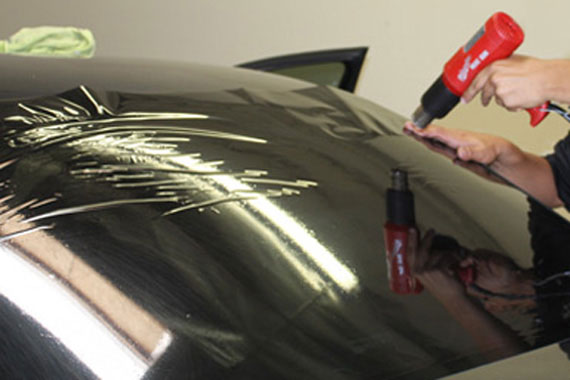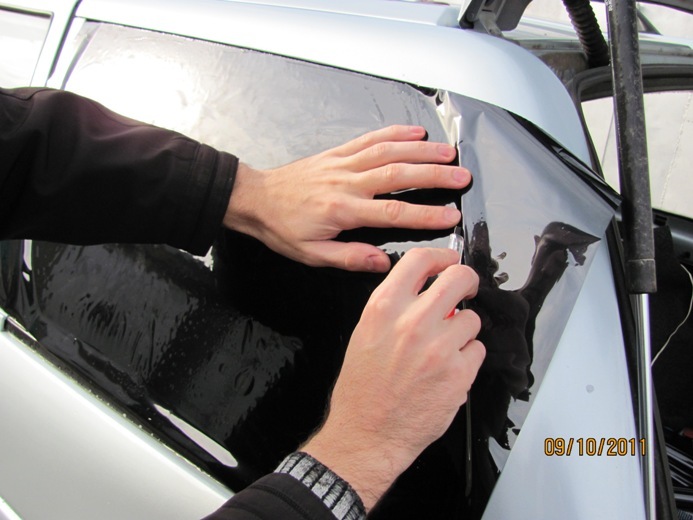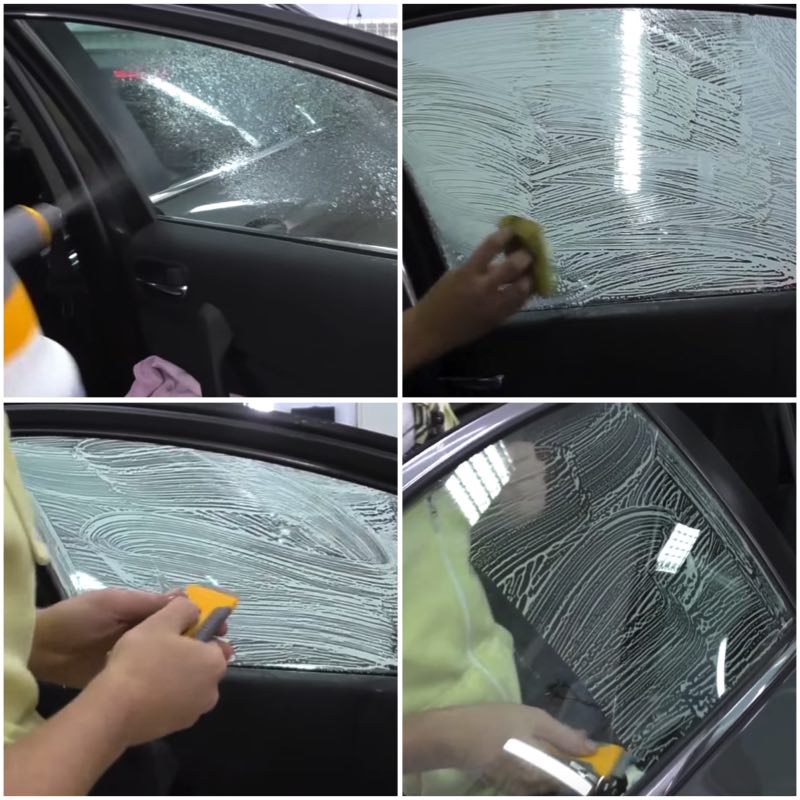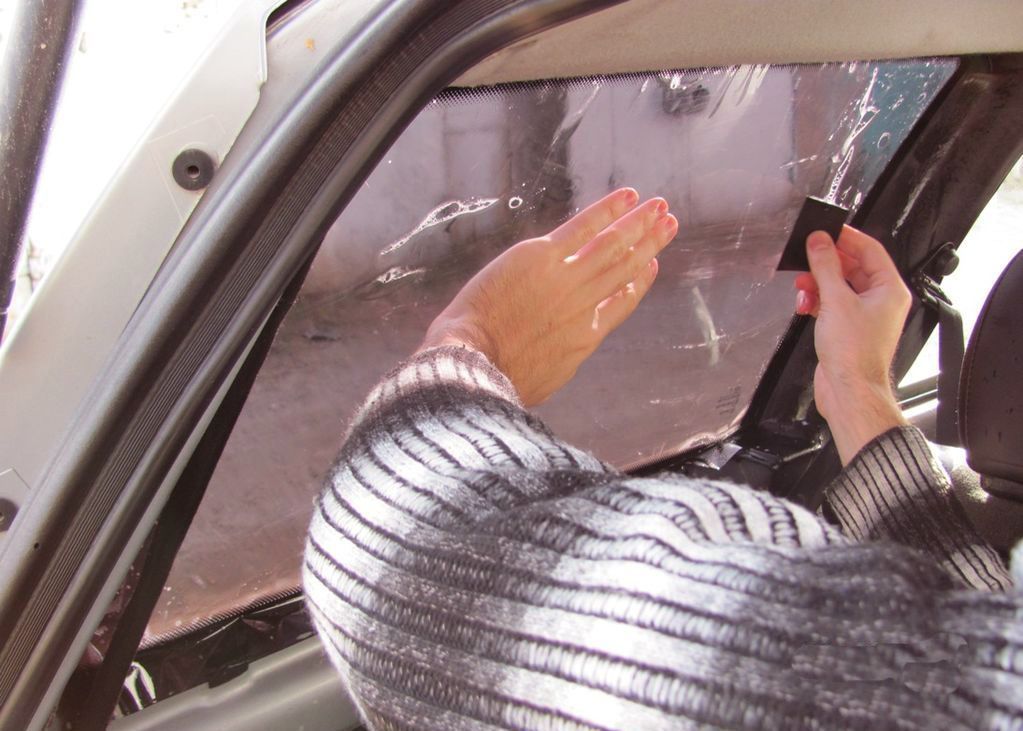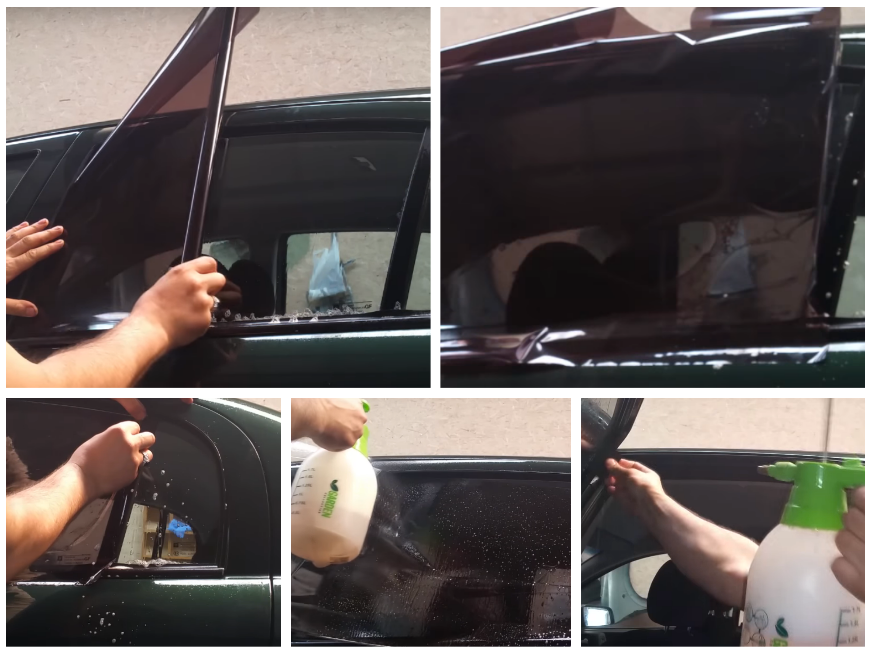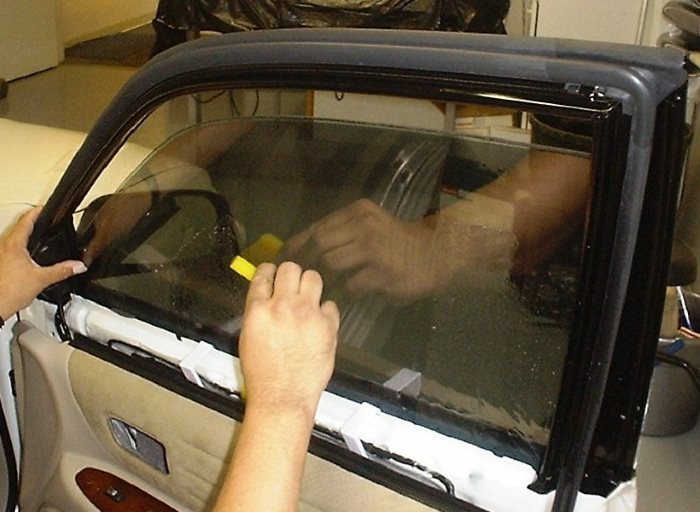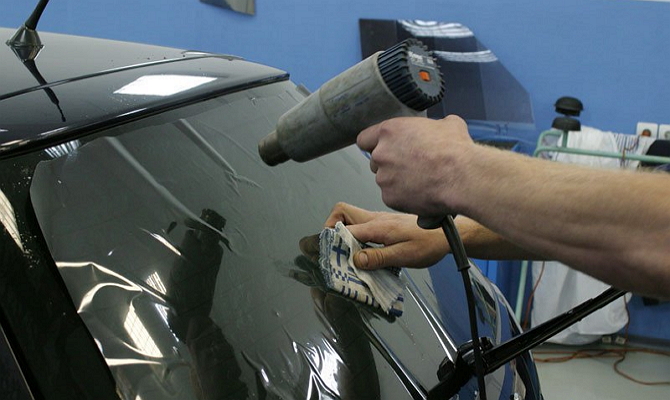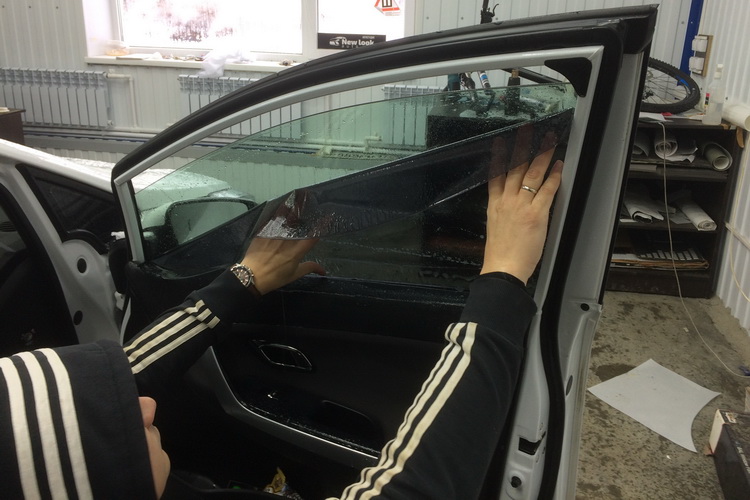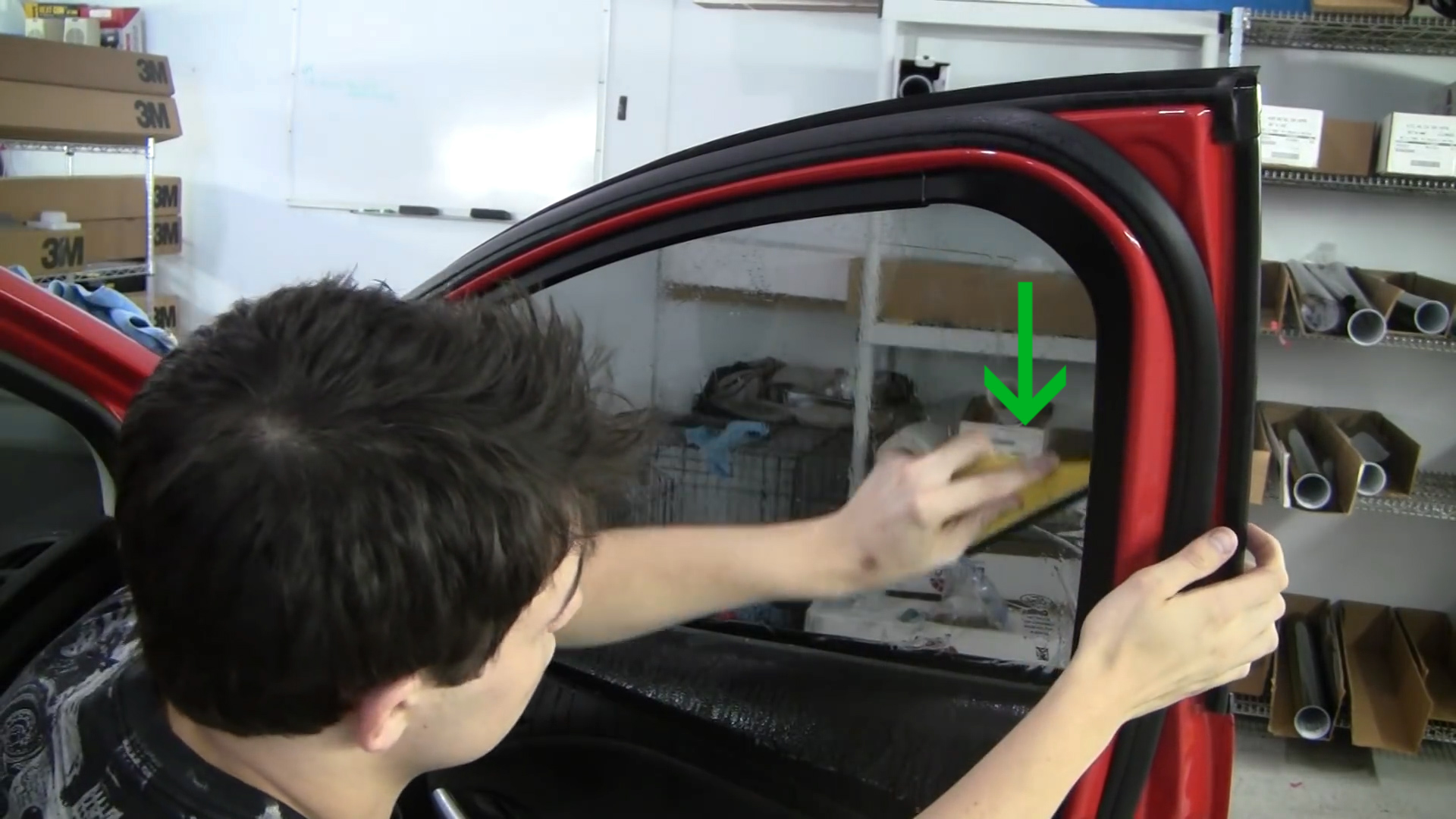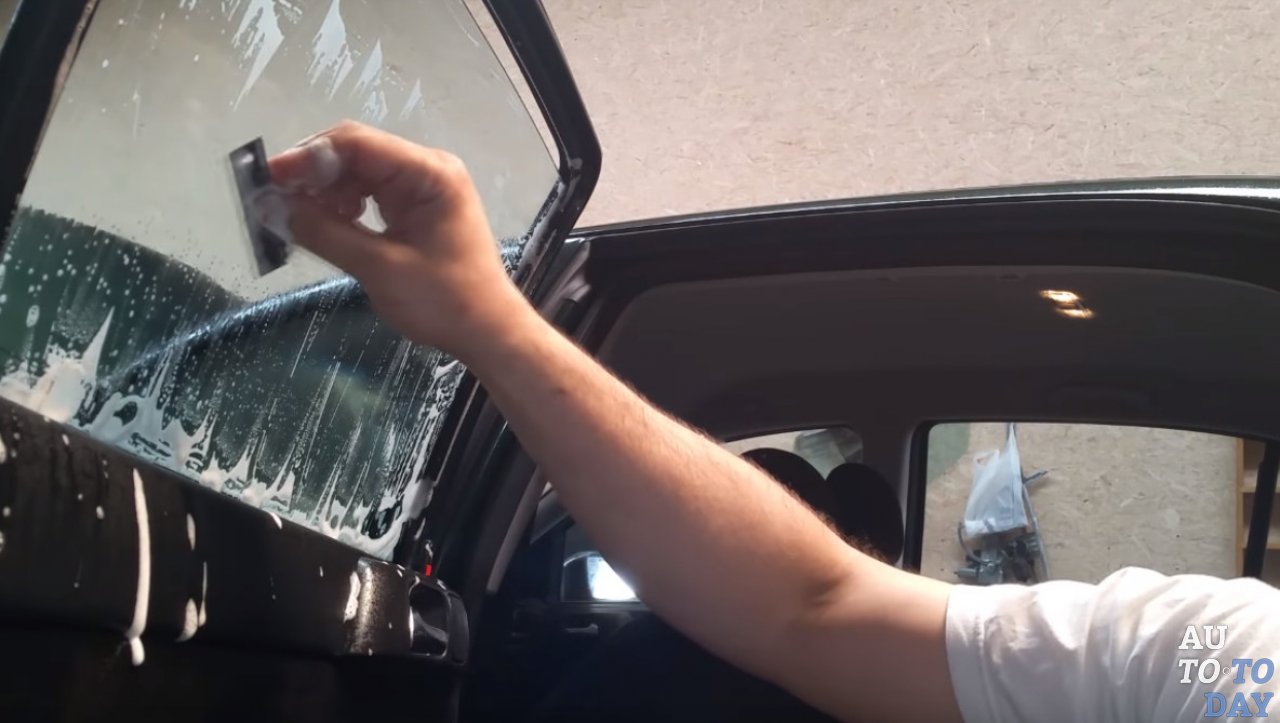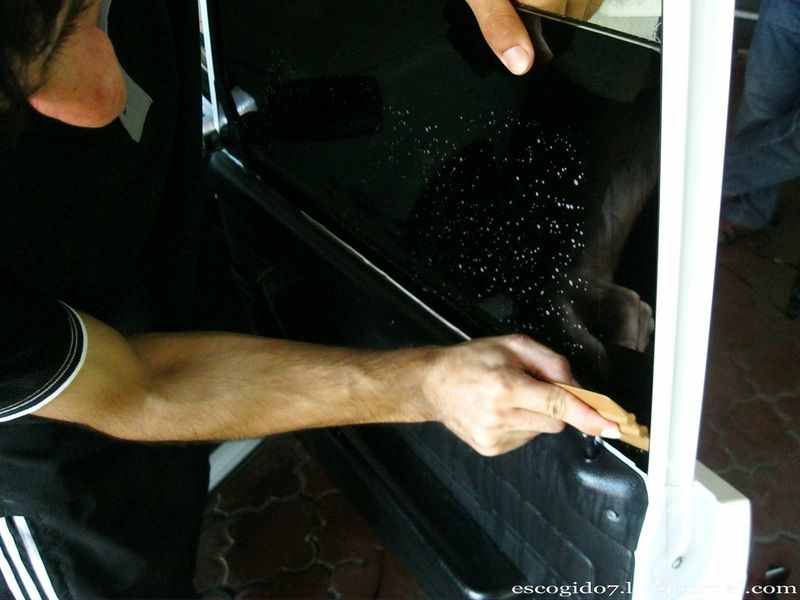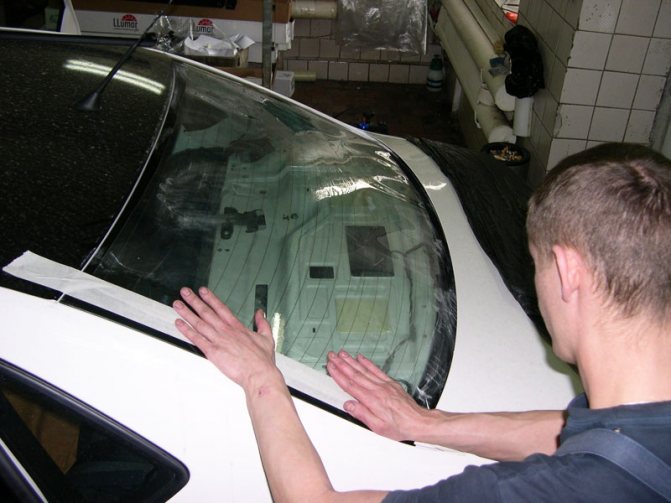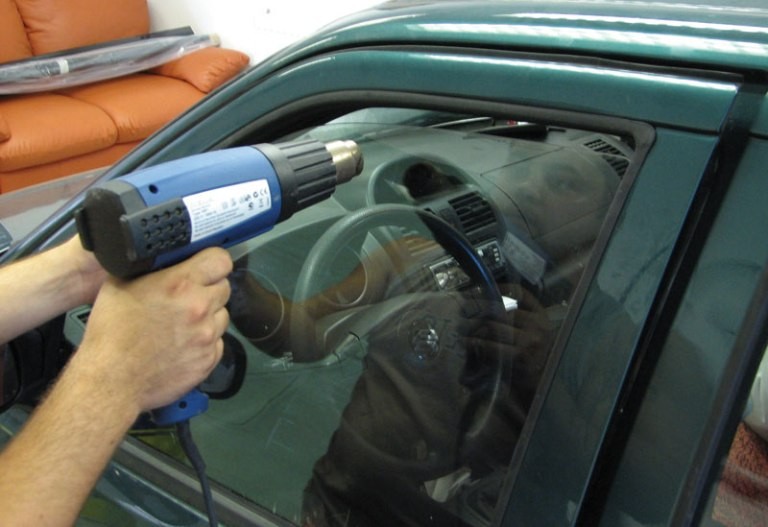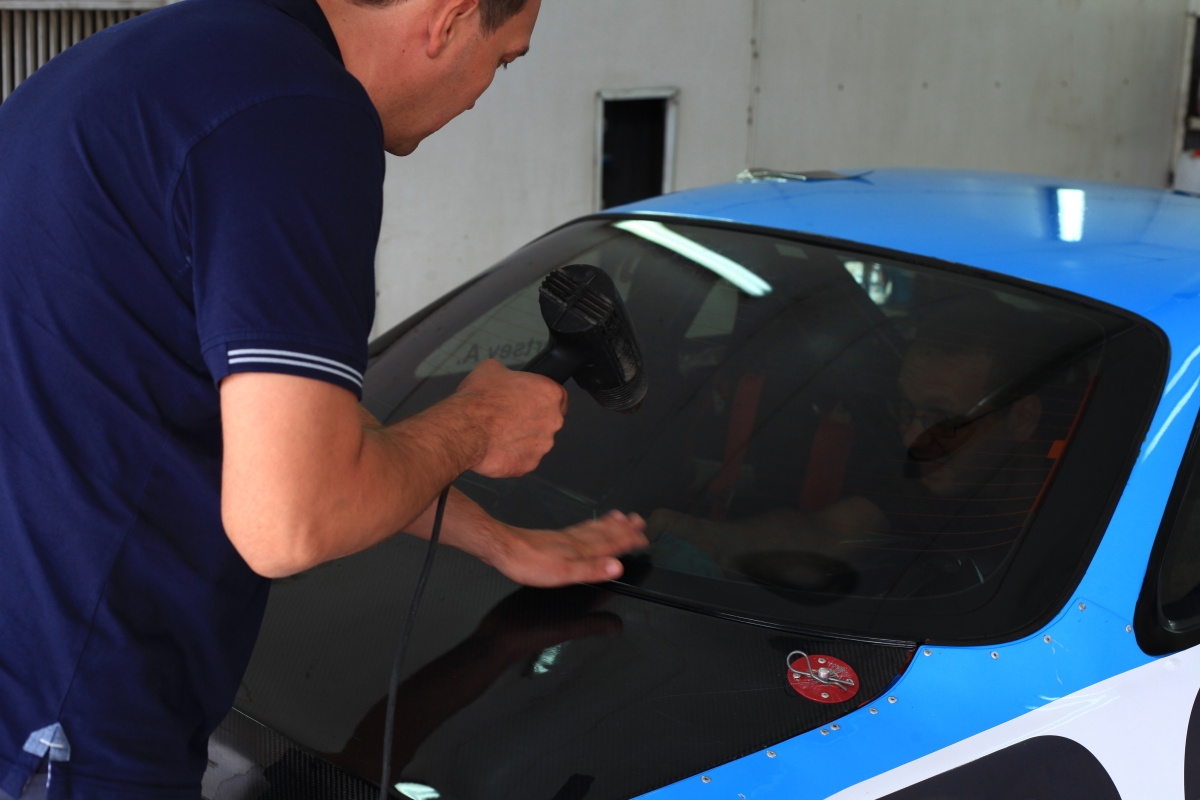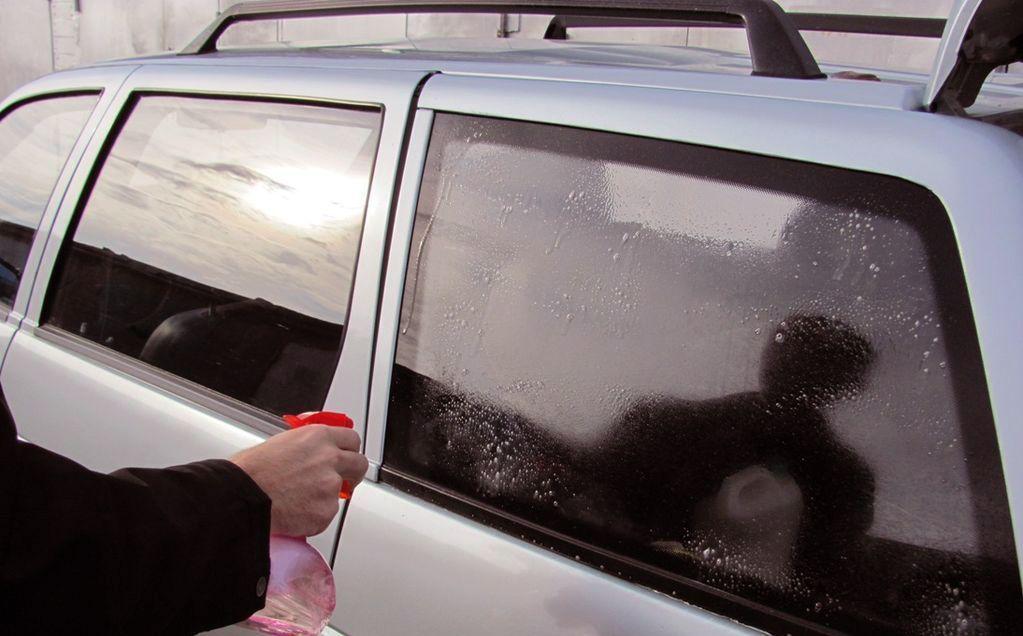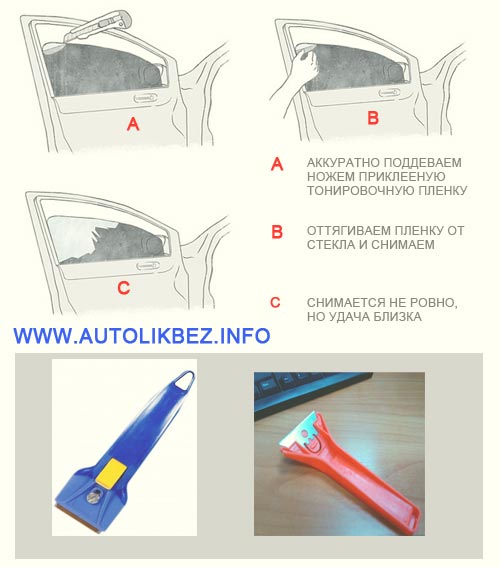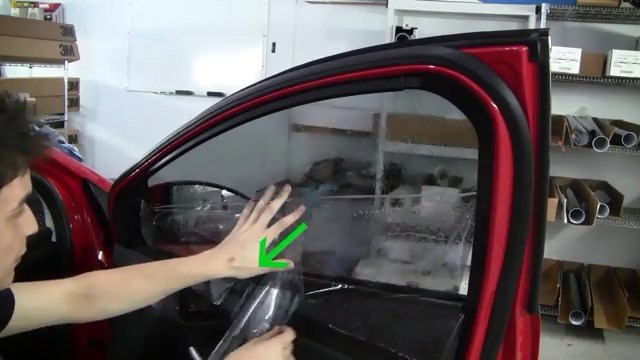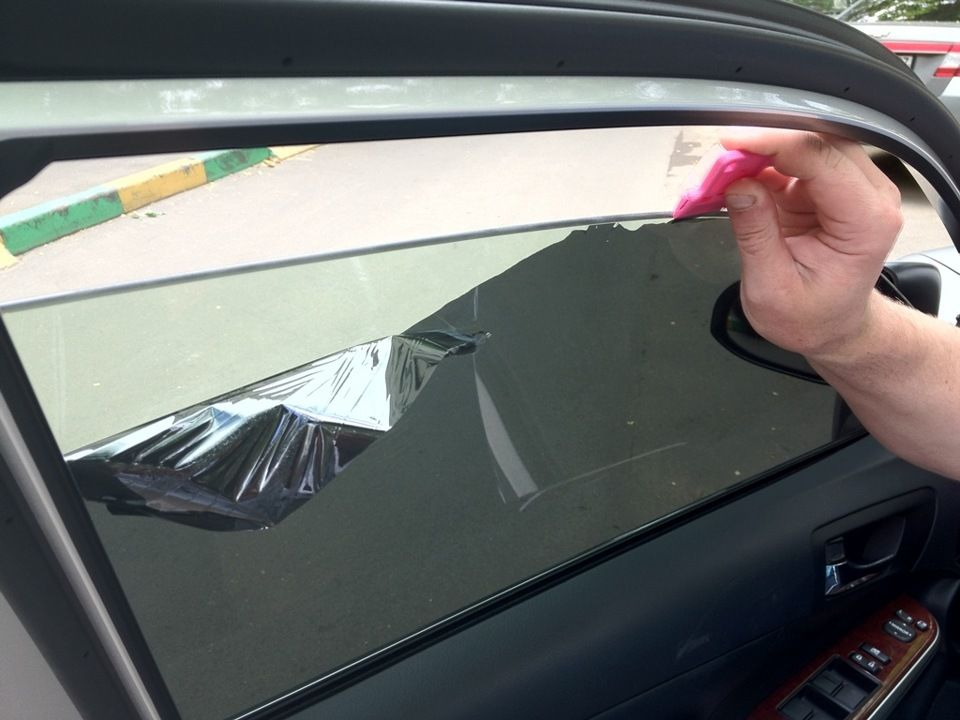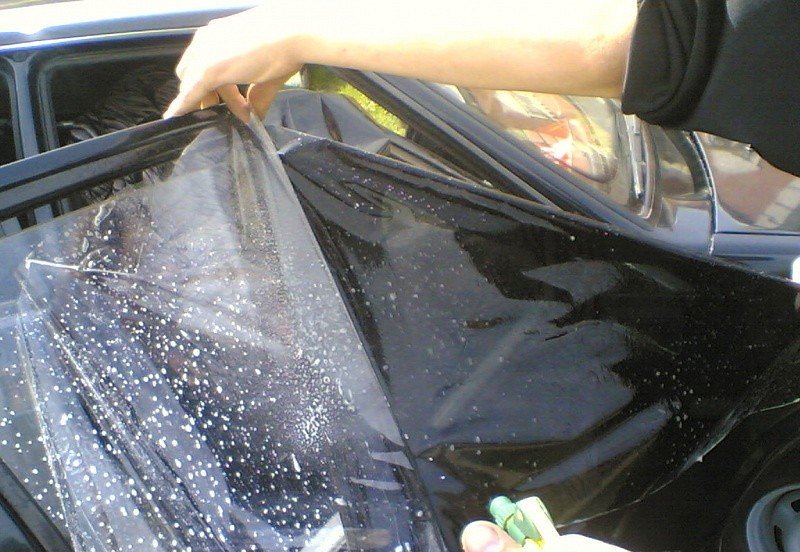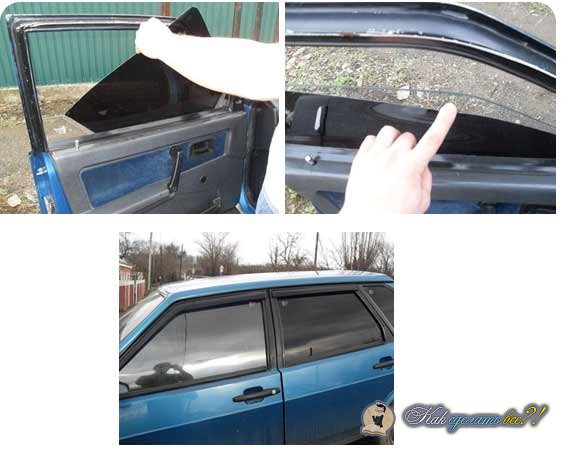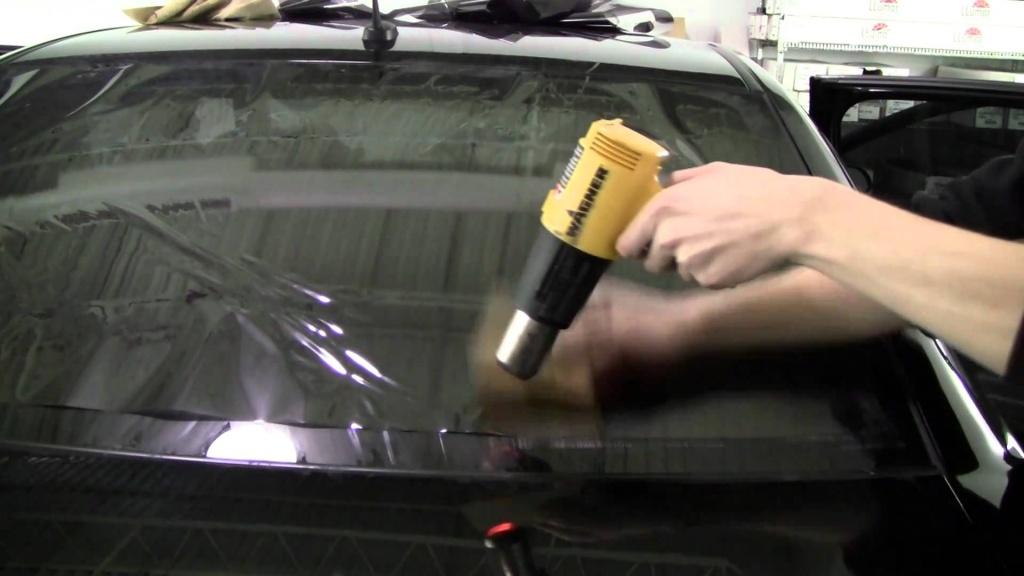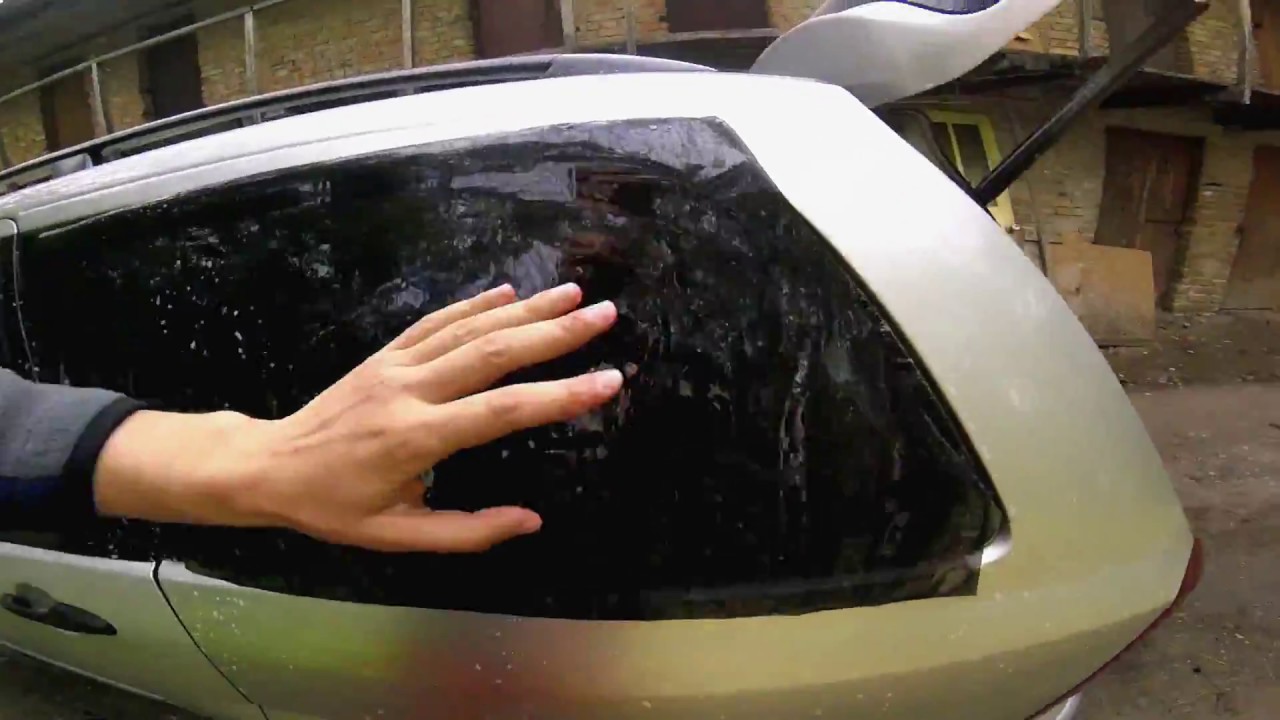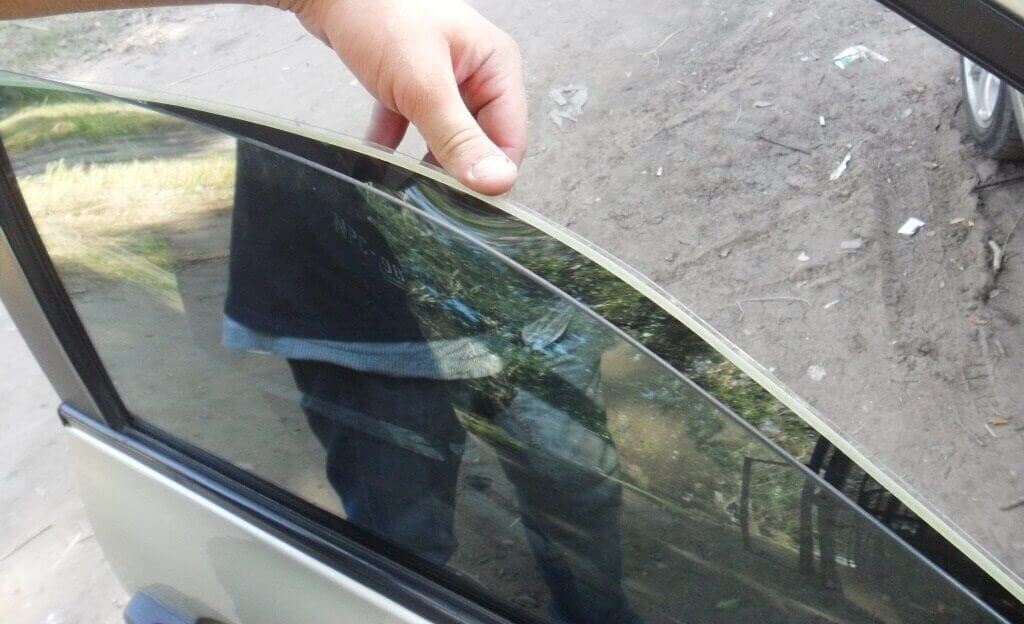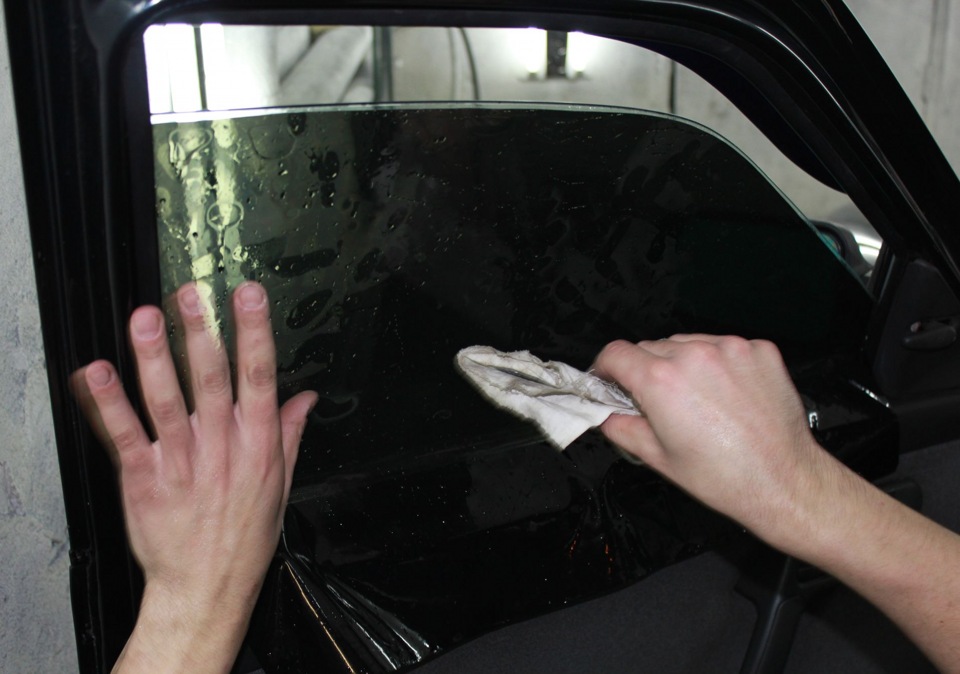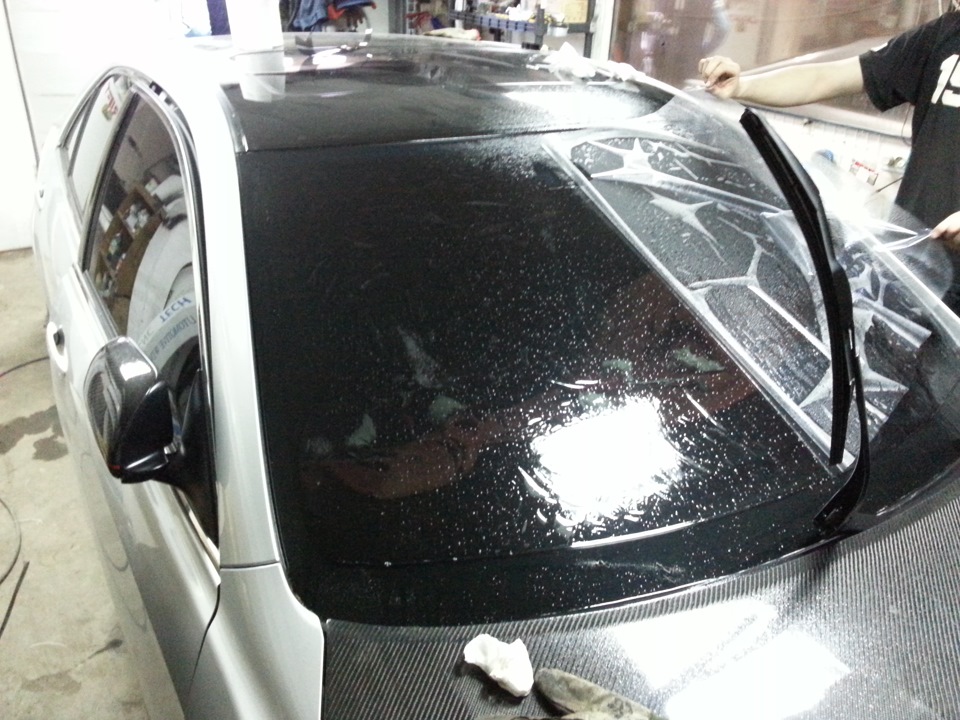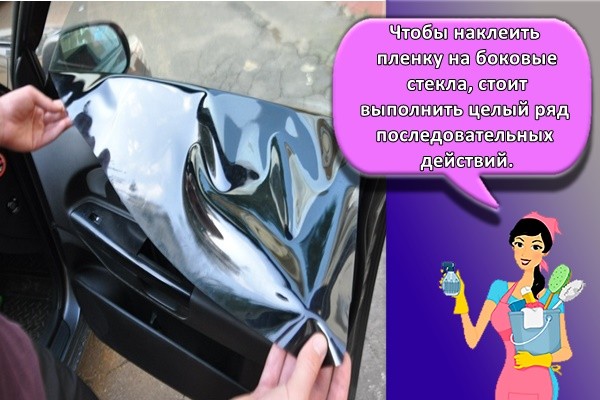How to glue tint
First you need to prepare blanks of films corresponding to the size and shape of the glass. Cutting the films to the shape of the glass with a small allowance of 5-10 mm can be made directly on the glass. You need to sprinkle water on the glass and apply a film that should stick to the wet glass. Moving the film over the glass surface, we set it so as to obtain minimal waste. Now you can carefully cut the film with a sharp knife along the contour of the glass, leaving the specified margin.
When cutting the film, you need to be very careful not to accidentally cut it in the wrong place or scratch the paint on the doors. In order not to risk the tinting film once again, you can first make a pattern from a regular film or tracing paper, and then cut out the workpiece from the tinting film with scissors.
After the blanks are cut and prepared, you need to thoroughly wash the tinted glass from the inside, where you are going to glue it, with a glass cleaner.
The main secret of the tinting masters at the service station is the agent that they spray on the glass before gluing the tinting film. Without it, car glass tinting is not so smooth and flawless. This tool is designed to temporarily neutralize the effect of the adhesive base of the tinting film until it finally takes its place on the glass. The miracle remedy is a 10-20 percent shampoo solution, which you can prepare yourself and pour into a spray bottle.
Video: DIY tinting
Using a spray bottle, cover the glass surface with a continuous layer of shampoo. Peeling off the protective coating of the film from one of the upper corners, we stick this corner to the corresponding place of the glass
Pressing the tinting to the glass, carefully pull out the entire protective layer of the film from under it. The operation can be done slowly, since the adhesive base is neutralized with shampoo for 20-30 minutes
After the protective layer of the film is completely removed, the film itself remains adhered to the glass and moves freely. It is necessary to finally fix its position and start gluing the tinting to the glass.
For the film to adhere, you need to remove the shampoo and air bubbles from the contact space. This procedure is performed by smoothing the film against the glass using a sticker, starting from the middle to the edges. Air bubbles are clearly visible on the outside of the glass in the form of white spots. The shampoo solution squeezed out along with the bubbles is removed with dry wipes. The rest of the film along the edges of the glass is cut off with a knife, not reaching 1-2 mm to the edge, except for the lower part. At the bottom, the film is cut off with a surplus of 2-5 mm, which is tucked under the sealing gum so that the edges of the tinting do not tear up when the glass moves down.
After finishing work, the film must dry for at least 24 hours. During this time, do not touch the glasses, lower them, turn on the heating. The adhesive base of the tinting, gradually drying out, will reliably fix the film on the glass surface.
How to glue the tint on the rear window if its bend prevents the film from being evenly distributed?
In this case, you can stick the film in separate 2-3 strips. You need to start gluing the strips from above, allowing an overlap along the electric heating lines of the glass. Carefully cut and remove excess film exactly along the heating line so that the joint remains invisible. Gently iron the strips with a rubber spatula to remove excess water and air.
The choice of material for tinting
There are several ways to darken car windows, but for self-tinting, it is better to use the film wrapping method.
It is important to know how to properly stick the film, and what material is better to choose. The film can be:
- simple, with an adhesive base in black;
- multi-colored;
- transparent, with various patterns;
- metallized, with different levels of shading;
- with rolling colors;
- "Chameleon" with a mirror surface;
- silicone;
-
perforated.
The quality of the tinting and its service life will depend on the toning material.
By watching the video, you will learn more about the types:
A little more effort will be required to tint the glass with roll material, since it needs to be cut out by yourself. The cost of such material depends on the density and level of shading. The range of colors is presented in a wide range, so there is an opportunity to choose for every taste.
Rolled tinting material has such advantages as:
- dense structure;
- strength;
- resistance to mechanical damage;
- ease of gluing;
- ease of removal.
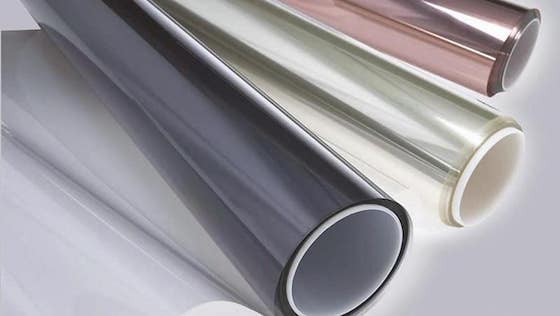 Tinting material comes in the form of a roll (click to enlarge)
Tinting material comes in the form of a roll (click to enlarge)
This material is called removable tinting, since the glass under it remains unchanged and you can re-glue this tinting as much as you like.
Removable tinting is made in standard length, and one roll is enough to cover all the windows of the car.
When choosing a film, it is necessary to take into account its light transmission. The tinted windshield must transmit at least 50% of the light. The film covering the front side windows must have a bandwidth of at least 35%, the rear side windows and the trunk - 15%.
Headlights are a separate issue. Can I tint them? It is possible to glue the tint on the front and rear lights only on condition that the color of their glow and light transmission are preserved. With headlights that are tinted in a different way, there is a possibility of not passing the inspection and getting a fine.
Application of a film for tinting on the side windows of the car
Moisten the surface of the side glass and use a scraper to clean the bottom of the glass. Then lower the glass a few centimeters, moisten and also scrub the rest of the surface with a scraper.
Clean the surface with the blade consistently and make sure there are no uncleaned areas.
Next, wash the glass with a hard sponge and wipe dry with a rubber forcing. Wipe the edges of the glass with a napkin. Moisten and wipe the glass again with a rubber brush.
- Moisten the glass generously before applying the tinting film.
- Then, two-thirds of the liner protecting the adhesive layer must be removed from the workpiece and the adhesive surface must be moistened. It is convenient to carry out this operation on the rear window of the car, attaching the pattern with an adhesive layer outward.
- It is better to cut off the excess liner removed from the workpiece before applying the tint film.
Wet your fingers. Keep your fingertips clean as you will need to touch the adhesive layer of the film while tinting the glass.
Gently take the workpiece and place it on the prepared glass surface.
Try to keep the adhesive layer only touching the glass surface and not touching seals and other surfaces.
Align the tinting film with the top edge. Make sure that there are no gaps or gaps anywhere, and begin to gently squeeze the solution out from under it.
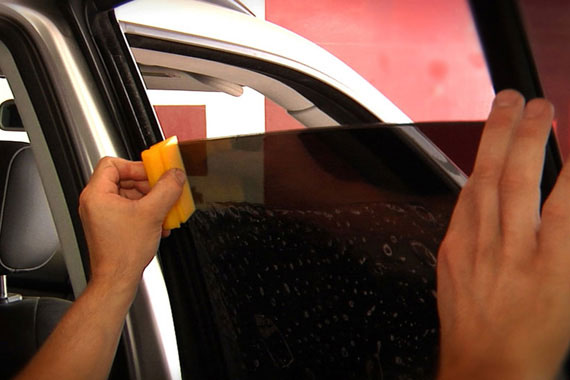
Follow a few simple rules:
- Hold the pattern with your hand, as the initial squeezing out of the liquid will cause the workpiece to slide over the glass.
- Squeeze the water out from the center outward.
- Use a rubber and then hard forcing. Rigidly forcing the liquid out in the same directions - from the middle to the edges.
- Then use a forcing machine and a hair dryer to fix the film at the top edge of the glass.
- After that, using a knife, remove the excess tint film protruding onto the upper edge of the glass - this technology allows you to leave no gaps along the upper edge.
Lift up the glass. Fold back the bottom of the pattern protected by the liner and moisten the glass liberally with the solution. Remove the liner completely.
Do this very carefully and make sure that the film without a liner does not touch anything except glass with its glue layer!
Carefully tuck the tint film under the glass seal
Squeeze out the horizontal inner seal using forcing and, when filling the tinting film, make sure that it does not break - this operation also requires certain skills, so be especially careful (note how the wizard will carry out this operation in the video tutorial below)
- Squeeze the solution out from under the film using a hard forcing: squeeze out the water in successive movements from top to bottom and from the middle to the edges.
- Finally, remove the remaining moisture using a distillation wrapped in a napkin and a hair dryer.
- Make sure there are no water bubbles left under the film during the toning process.
The technology for cleaning and sticking small blind glasses will be identical.
How to properly glue the film on the back
According to the principle of operation, the pasting of the rear window does not differ from the side curved one. But the larger size and inaccessibility significantly complicates the process (if the station wagon is, of course, lighter).
- Let's briefly fix the procedure in memory. Without a "magic" solution, nowhere. Therefore, we start by spraying it onto clean glass.
We apply a roll of film to the glass and cut it off with a margin of 2–3 cm. Then we level the tint clearly across the window and cut off the excess. Smooth out from the center and remove the wrinkles with a hair dryer and forcing.
- We achieve a perfectly clean inner surface of the glass and moisten it abundantly with soapy water.
- Let's move on to the last step. It is highly recommended to find a partner at this stage. A large piece of film is difficult to handle alone. Remember to constantly spray soapy liquid on the adhesive and on the glass. It remains to get rid of air or water bubbles. The film must also adhere evenly.
For a better visualization of the process, watch the video.
General order of work
Glass tinting is carried out using a water-soap solution in a proportion of 3 - 5 drops of detergent shampoo per liter of water.
Stir this solution thoroughly, preferably using an automatic sprayer.
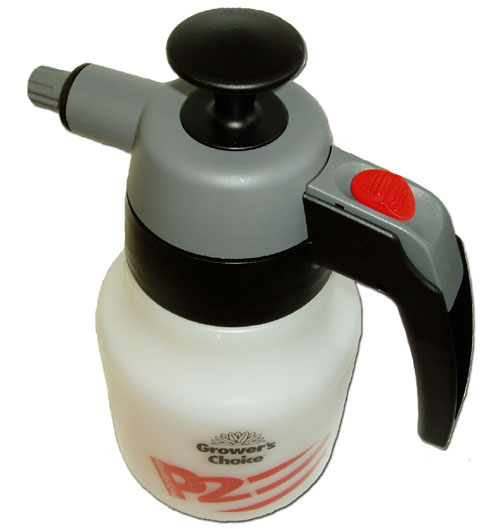
Then the external cleaning of the glasses is carried out. This must be done not only without fail, but also very efficiently, since the technology requires complete cleanliness of the tinted surface. Any grain of sand can end up as an air bubble.
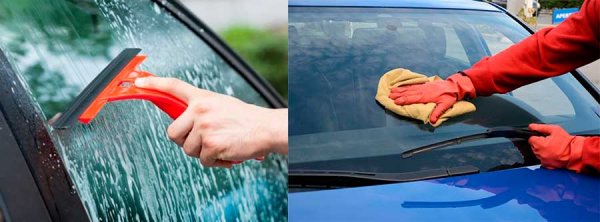
In this way, you can tint any domestic and foreign cars.
General stages of work:
FIRST STEP. The glasses are cleaned of dust and dirt, as well as degreasing. If you are going to tint glass without removing them, it is advisable, but not necessary, to remove the rubber seals.
SECOND PHASE. It consists in making a solution of shampoos or non-aggressive detergents. It needs to be poured into a special spray bottle.
Pay attention to the correct preparation of the solution. 5 drops of detergent are added to 1.5 liters of water and the whole mixture is shaken vigorously
It is better to pour the resulting solution into a container with a spray (sprayer).
THIRD STAGE. Creation of patterns from paper. They will be required in order to cut the tint film of the required shape. If you are unsure of your measurements, please allow small tolerances. They are then easily removed with a cutter. If the hand is already full, then this point can be missed.
FOURTH STAGE. The pattern and the very process of toning itself.
Preparation and tools to tint the car
We figured out the laws, chose the film - now you can start working. Immediately you need to choose a suitable place for the upcoming manipulations. The street is not very suitable for this. Dust, insects, wind and direct sunlight are the main list of unacceptable conditions. A spacious garage or box is ideal.
So that the execution process does not stop at the "most interesting place", prepare all the tools and materials in advance. You will need:
- The very tint film in the required amount. Decide how many glasses you will tint and calculate the area. Consider a 10-20% margin for fit.
- Water spray in any form. Needed for spraying soap solution.
- Liquid soap or Fairy, clear water.
- Something sharp and cutting: a regular blade, a stationery knife, a scalpel.
- Lint-free napkins.
- Forcing is a special spatula with which you will remove the solution from under the film. Must be firm, but free from sharp edges. Usually they are plastic and some manufacturers put them together with a film. If you are unlucky, then look for them in construction or automotive stores, and they are sure to be found in shops for outdoor advertising masters.
- Special scraper for cleaning windows (optional, greatly facilitates the cleaning process).
- Electric building hair dryer with temperature controller (we need 550 degrees Celsius).
Pros and cons of tinting
Toning is a fashionable and widespread phenomenon in our time. Cars that do not have a single tinted window are a rarity. Finding yourself in such a salon, you feel somehow unusual.
This is why most car owners tint their windows and many of them try to do it on their own. What is good about toning and what are its significant disadvantages?
Let's talk first about the pros, among them the following can be distinguished:
- in sunny weather, the interior warms up less and does not fade;
- the sun does not blind the eyes, the cars behind it too;
- the driver and passengers are not so visible from the outside;
- poor visibility from the outside allows you to leave any things in the cabin;
- if a film was attached to the glass, then the glass will not crumble upon impact.
As for the cons, they are as follows:
- in some cases, you have to pay a fine for the use of tinting;
- it is dangerous to be with a stranger in the cabin of such a car (most often concerns those who like to give a ride to a fellow traveler);
- it is very difficult to park in pitch darkness;
- in the dark, the tinting becomes a mirror.
Today, the use of car tinting has been tightened, so many people think about whether to do it or not. Knowing about the pros and cons, it is always easier for a person to decide.
How to make and stick with your own hands: instructions
To avoid mistakes in self-creation and subsequent gluing of removable tinting, you should follow the step-by-step instructions. To make the film, you must perform the following steps:
Remove the mold from the glass. First you need to glue the transparent protective layer from the film, gently smooth it over the surface using a solution of soap and water, and using a knife, cut off the side contours and the bottom along the sealing rubber tabs. After that, you need to slightly lower the glass and cut off the film along the upper border. The result is a transparent glass-shaped sample.
Having prepared the pattern, you need to transfer it to a sheet of thick paper and insert it between the glass and the seals. Next, you need to lift the glass to the end and fit all parts to the seals. If the contour along the top will not coincide evenly with the edges of the glass, you need to cut off the protruding elements and ensure that the boundaries match exactly.
Having adjusted the pattern to the size of the glass, you can remove it and cut plastic blanks on its basis.To speed up the process, workpieces can be made in pairs, since the right and left glasses have the same dimensions and shape. Having cut out the blanks with metal scissors, it is worth processing them with sandpaper along the edges.
After creating the blanks, you need to prepare patterns from the tinting film. Removable tinting requires gluing the blanks on both sides, so you need to cut two pieces of film of the same format. Then it is enough to remove the layer of protection from one side and wait for the disappearance of the static effect.
The entire area of the polyester workpiece must be wetted with soapy water 10-15 minutes after the previous step. A similar procedure is performed with tint film using a spray bottle. If there is not enough moisture, the film may not stick reliably in the future.
The processed film should be applied to the plastic blank and flattened over the entire area using forcing. After careful alignment with a knife, the excess edges are cut off along the glass contour.
After applying a tint film to all blanks, dry the resulting products for a couple of hours
In this case, it is important to monitor that air bubbles do not appear on the workpieces. After the first side is completely dry, you need to let the second dry
The result is a ready-made removable tinting, for gluing which it is enough to attach it to the glass.
How to put and remove the film on static
Having made a tinting for auto glass by yourself, you can quickly install it on windows and remove it when not needed. A well-made pad will fulfill its purpose for many years.
Stages of tinting
As much as you would like to start gluing the tint film as soon as possible, you first have to do a little preparation.
Preparation of funds and tools
It is better to prepare everything you need in advance than to search for the necessary tools and materials later in a hurry. Or, even worse, use different means at hand. So write down or remember right away what you need for tinting with your own hands:
Tinting film
On average, the side windows and rear window take about 3 m² of film - 2 m² and 1 m², respectively. The windshield is usually not tinted. If you are doing tinting with your own hands for the first time, we recommend buying a film with a margin.
Spatula or scraper
What exactly to choose - a rubber spatula or a plastic scraper - is a matter of taste. For example, we prefer to work with a soft trowel, which, unlike a hard scraper, does not leave micro-scratches.
Shampoo
You will need it to prepare a soapy solution that you will use throughout your work. The shampoo can be anything, the main thing is that it does not contain aggressive chemicals.
Building hair dryer
This is one of the most important tools. You can also use a regular household hair dryer, but in this case, the work will take much longer.

Car preparation
After you prepare the necessary materials and tools, wash the glass of your car on both sides, on which you will stick the tint film. There should be no dirt, stains or traces of sand on its surface.
As soon as you are done with the sink, make a solution: dilute a few drops of shampoo in warm, clean water. Pour the resulting soap solution into a spray bottle. This completes the preparatory work, and you should start tinting the windows.
The entire operation of pasting with foil should be carried out in a dry, warm and clean room. Ideally, if it will be a separate well-lit box.
Tinted glass
There are 7 main stages in the tinting procedure. The main thing is to be extremely careful and strictly adhere to the instructions, then you will not have to redo anything, and the result will meet your expectations.
Making a "pattern"
Take a roll of tint film and roll it out. To understand how much film you need, place it on the glass with one hand and mark the approximate crop margins with a marker using your free hand. After that, cut off a part of the film with a clerical knife with a small margin - a tolerance of a few millimeters. Then put aside your pattern for a while.
Remove the protective layer
We very carefully separate the protective layer from the tint film. Lubricate the side that will stick to the glass with soapy water.
We glue the film
Apply a film to a damp glass surface
It is important to ensure that no horizontal folds appear. If vertical ones appear, this is not scary, since then they can be straightened quite easily with a spatula or scraper.
Some masters believe that tinting the rear window is more difficult to do on your own than tinting the side windows. However, the procedure is exactly the same: the film is glued in exactly the same way, as you can see in the video.
We level the film
Carefully, so as not to tear, level the film on the car glass. Movements with a spatula (scraper) should be from the center to the edges. At the same time, warm up the film with a construction hairdryer - it softens and smoothes more easily.
Since it is difficult to level and warm the film yourself, ask someone to help you. For example, you smooth the film with both hands, and your assistant works with a hairdryer.
Cutting off excess
Since we took the film with a margin, there will be a surplus. Cut them off with a clerical knife. You can step back a little from the edges of the glass so that the film does not peel off over time in these places.
Dry
The final stage is drying. Leave the car in a warm room for 3-4 hours. But remember that the film will dry completely only after 2-3 days. All this time, the car must stand with open windows. That is why it is best to do tinting in a special closed box.
We also recommend watching the video materials to see with your own eyes how each stage of toning goes at home.
Preparing everything you need
Before applying the tinting, you need to prepare a clean and dry place for work, as well as a standard set of tools:
- Tinting film that meets the requirements of GOST 5727-88. The light transmittance for the windshield should be at least 75%, for the side front - 70%, for the side rear and rear - any. Usually, 1 roll of film filter is used for 4 side windows.
- Liquid soap (no dyes) for fixing the film. It is better to use special setting compounds that do not leave streaks, or a 10-20 percent solution of any transparent shampoo.
- Plastic sticker for smoothing the toning. It usually comes with a film filter, but if not, you can use any resilient plastic, rubber spatula or construction rubber eraser. Also in the store you can find special distillations for eliminating bubbles (chiseller - for hard-to-reach places, slummer - for tightening the edges, bloomax - for expelling liquid).
- Scrapers for cleaning glass surfaces. Products of 12 cm in different shapes are best suited.
- Spray gun (manual) for applying soap solution.
- Blade or utility knife. The latter is made of mild steel, so it is convenient for them to cut the film without fear of scratching the glass.
- Soft rags, clean rags or lint-free cloths.
- Industrial dryer.
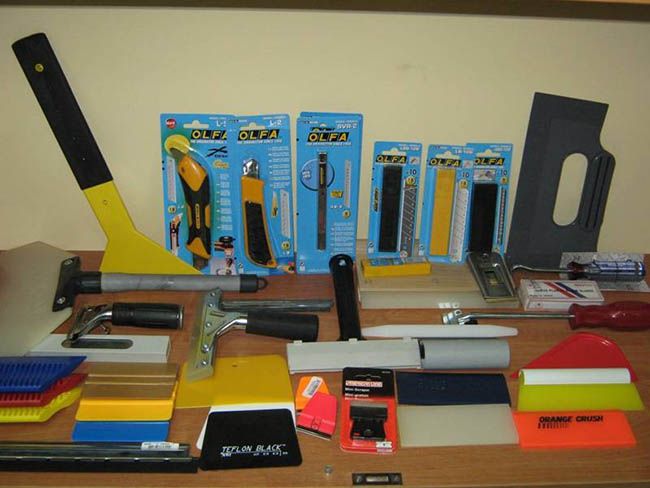
If toning the car with your own hands is done for the first time, it will not be superfluous to purchase special masking markers and tapes. With their help, you can correct minor errors.
You also need to make sure you have easy access to clean, cold tap water. The room should be free of insects and dust.
If everything is ready, you can start cutting the film filter.
Removable tinting characteristics
Removable tinting is a film with a static effect of adhesion to car glass. In terms of external characteristics, it differs slightly from ordinary film. The only noticeable difference is that after its gluing, there is a haze effect, which disappears as a result of shrinkage.
The main characteristics of removable auto-toning include increased resistance to low temperatures and mechanical stress. During long-term use, the film is not damaged or deformed. Removable tinting perfectly protects the interior from ultraviolet radiation and does not interfere with normal illumination.

Option of plastic removable tinting
A distinctive feature of the removable film in comparison with the usual one is the possibility of reusable use without loss of proper appearance and effectiveness. Regardless of the number of removal and re-installation with your own hands, it will protect the interior of the car and firmly adhere to the glass.
Window tinting step by step
First, you need to dilute the soapy solution and thoroughly rinse all the glass with it. Before carrying out this stage of preparation, it is necessary to dismantle the rubber seals from the glass. Glass treated with soapy water must be thoroughly wiped with paper towels or a lint-free cloth.

After that, it is necessary to sprinkle the outside of the glass with soapy water and attach the film to it, directing its transparent side towards you. With a knife, it is necessary to outline the boundaries of the future pattern, stepping back from the edge of the glass about 1-2 cm.
Then you need to spray the inside of the tinted glass with soapy water. It is necessary to attach the film with the adhesive side to the glass, carefully cutting off the bent liner. If the film lies flat and without gaps, then you can begin to gently squeeze the soap solution out from under it using a rubber spatula or forcing. You need to act carefully. Pressing too hard can scratch the tint.
After the tint has already been glued to the center of the glass, it is necessary to tuck its lower edge into a rubber seal. You must act carefully and slowly. At this stage of tinting, creases and distortions should not form. After that, it is necessary to squeeze out the remains of the soap solution from under the film.
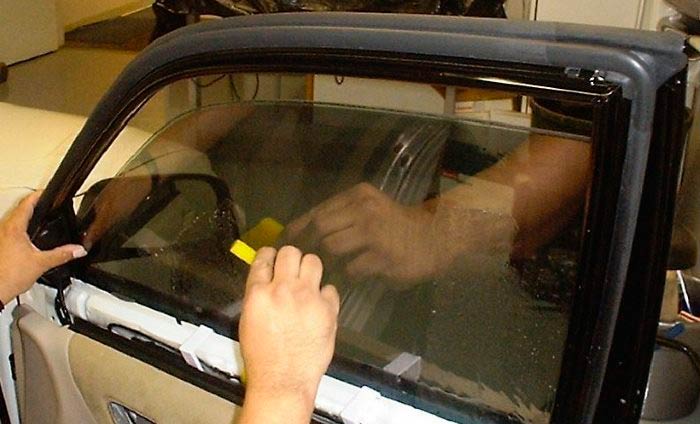
After the tinting is glued to the glass, it is necessary to cut off its excess with a knife. Remove excess film around the edges with sharp movements. The knife must be sharp. The final stage is drying the treated glass with a hairdryer. If it is not there, then it is necessary to close all the doors of the car. There should be no drafts in the room where the car is toned.
Experts do not recommend returning the rubber seals to their place earlier than two days have passed since the tinting.
How to stick the tinting yourself
Apply the tint coating only to clean glass. If the work is carried out indoors, it should be free of dust. Contaminated air is one of the causes of bubbles. If you perform the actions without removing the glass, then the interior should also be clean.
If, due to the complexity, you want to refuse to work, there is always the opportunity to contact the service. In addition to the fact that the window should be smooth, all unnecessary things should be removed from it, for example, an antenna.
What is needed
Before work, you need to prepare the tool and material. Among all that may be needed, consumables should not be neglected.

- Tinting film. The quantity should be sufficient for side windows, as well as front and rear glass.
- Spatula rubber and plastic scraper.
- Shampoo.
- Spray.
- Stationery knife with a retractable blade.
- Lint-free cloth, dry.
- Clean and warm water.
- Home or technical hairdryer.
Also, before work, the material must be prepared.Cutting out the film is not a difficult task, and it involves cutting out pieces that will be 2-4 centimeters larger than the size of the tinted surface itself.
Car preparation
The next stage is the preparation of the machine itself. For the quality of work, it is imperative to wash the car and the workplace.
Even grains of sand can cause defects during work, so attention should be paid to the details. Apply the film only on a clean surface and in clean conditions
Therefore, the car windows must be pre-washed on both sides using a special detergent solution.
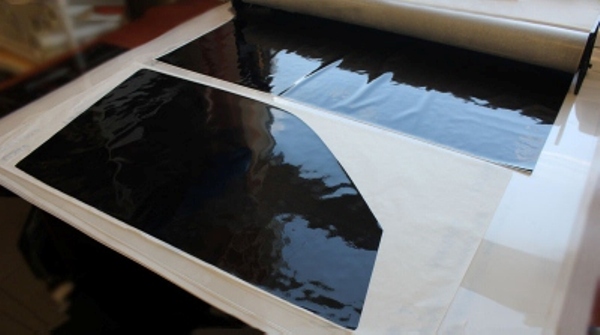
Even after washing, wiping the car with a soft cloth, you must make sure that no fluff remains on it - you cannot glue the toning material without bringing the coating to perfect cleanliness. Work should start from the side windows.
Only after pasting them, you can gain experience and proceed to the rear and front glass. Further, the process can go in two directions - removing the glass or not removing them. It is most convenient to remove the glass, the effect of this is much higher, although it makes you tinker, doing extra work.
We make the film ourselves
The advantages of tint film have already been described in detail, the question arises - how and from what is it made? The production of car tinting is based on polyester. The base for production must be of high quality, and very few companies produce such polyester. A classic film consists of several balls. Each is 20 microns thick. The manufacturing technique is rather complicated, the layers are rolled under a certain temperature.
It is very important that during use the film does not distort the appearance of things and the interior. For this, much attention is paid to the same physical indicators of the base in its different parts.
This property allows the film to be glued to any type of glass.
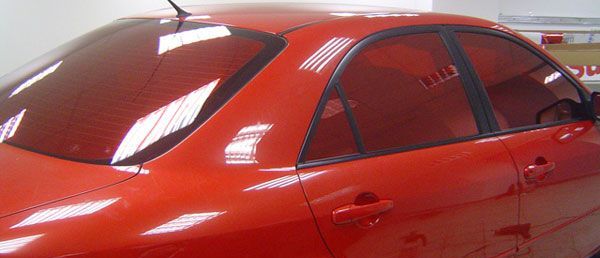
You can also tint your car at home. However, it is not possible to create a high-quality product that will meet modern norms, standards and operational requirements. Film for tinting is made using temperature and chemical composition at the factory; it can be an overwhelming task to recreate the process in everyday life.
Pasting technique
There is little difference in the methods of gluing the cover on the side, front and rear windows. Experts advise starting with the sides. Only then, after gaining experience, can the rear and windshield be coated.
The side windows are washed with water and a scraper before starting the procedures, after which they are wiped off with rubber forcing. The edges are wiped with a napkin, and hands are washed with soap before the second part of the work. The glass is moistened with soapy water, and the protective coating is removed from the pattern. The solution moistens the adhesive part, as well as the fingers. The film is carefully applied to the glass, the absence of gaps is checked and how smoothly the applied material is adhered. Excess water is removed. Forcing too hard can scratch the coating. The water is removed with progressive movements from the center to the edges.
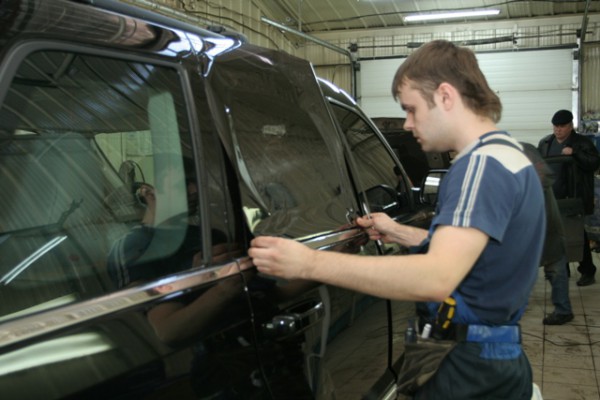
The upper part of the film cover is fixed a little later. The rest is also moistened with soapy water. The film is loaded under the bottom seal, no kinks should be allowed. The remaining liquid is removed from under the film with a hairdryer and distillation. There should be no water bubbles after finishing work. You can remove them almost immediately after tinting by walking over the glass with a rag or soft cloth.
Side window tinting
Initially, the seals and door trim should be dismantled in order to gain full access to the glass. Next, a pattern is performed. There are two options, use a thin graph paper template, or cut off a piece with a margin of a few centimeters.
In the second case, you should apply the tinting material on the outside to the wet glass and cut off all excess.Next, you need to remove the transparent protective layer from the tinting, while simultaneously treating the surface from a spray bottle with soapy water.
The final step is gluing the film to the glass; for smoothing, use a spatula, expelling air bubbles from the middle to the edges. After the material has been thoroughly smoothed out and takes its place, for several days until the adhesive layer has completely dried, do not use the window lifters, since the edges of the material may come off.
How to remove tint
If the film is damaged, begins to peel off, you are simply tired of it, or a traffic police officer requires it to be removed, it is quite easy to get rid of it with your own hands at home. But do not rush and in no case try to tear off the old film with a knife, scissors or the first objects that come to hand!
It is also forbidden to use aggressive liquids: acetone, white spirit, etc. These products will indeed dissolve the film, but the remaining tinting particles will stick even more and it will be very difficult to clean them on your own.
We offer you to choose one of two effective ways of self-removal of glass tinting:
Removal with heating
Heat the glass with a building hair dryer to 40-50 ° C, then pick up the edge of the film and pull it. So, gradually, with one hand, separate the film from the glass, while not forgetting with the other hand to warm up the surface with a hairdryer all the time. It is very difficult to cope with this task on your own, so it is better to ask a friend to help you.
If the rear window is heated, the technology for removing the film will be exactly the same. The main thing is not to damage the heating system with sharp objects.
Removal without heating
Gently pry off the edge of the film with a thin-end tool (preferably not sharp) and slowly pull on it.
After removing the tint, apply soapy water and wait 10-15 minutes. Then use a soft rubber or silicone scraper to remove the remaining adhesive and thoroughly clean the window.
We suggest that you familiarize yourself with the video of car tinting with your own hands. After watching the videos, you will get a complete picture of how to carry out each stage of the work yourself.
As you can see, it is quite possible to do tinting with your own hands if you first study all the stages of work and strictly follow the technology. We are sure that you will succeed!

